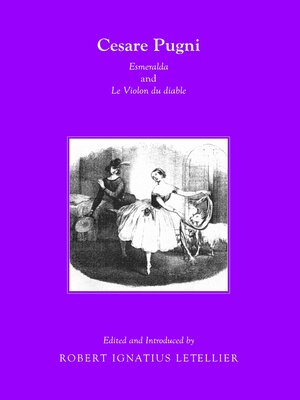
Sign up to save your library
With an OverDrive account, you can save your favorite libraries for at-a-glance information about availability. Find out more about OverDrive accounts.
Find this title in Libby, the library reading app by OverDrive.



Search for a digital library with this title
Title found at these libraries:
| Library Name | Distance |
|---|---|
| Loading... |
Cesare Pugni (1802–70) made his debut as a composer at La Scala in 1826 with the opera Elerz e Zulmida. In the 1840s he worked closely with the choreographer Jules Perrot (1810–92) in Paris and in London, creating some of the most renowned ballets of the 19th century, a number of which still find their place in some modern repertories. Pugni later followed Perrot to St Petersburg, and became official composer of the Imperial Russian theatres. Some of his earlier ballets were transferred to St Petersburg, and he also composed many new ballets for that city. Along with Perrot, Pugni also worked with Arthur Saint-Leon (1821–70), Paolo Taglioni (1808–84), Marius Petipa (1818–1910), and some of the greatest dancers of the century. His most famous collaboration, with Marius Petipa, lasted until his death on 26 January 1870.Pugni was extremely prolific, composing more than 300 ballets, a dozen operas, over 40 masses, other polyphonic works and a few symphonies. He was very popular with the public, who were delighted by his direct uncomplicated style, with its attractive melodies and infectious rhythms. Esmeralda, choreographed by Perrot and premiered with Perrot, Carlotta Grisi and Saint-Leon in the principal roles, was first performed at Her Majesty's Theatre in London in 1844. The ballet is based on the story of Victor Hugo's Notre-Dame de Paris (1831). It was reasonably successful, and Grisi was pronounced the perfect personification of the gypsy girl Esmeralda. The ballet later became immensely popular in Russia; Fanny Elssler enjoyed one of her biggest triumphs in the title role. Pugni's music successfully evokes an atmosphere of Medieval Paris, the changing moods of the story, and the delicate vulnerability of the heroine. For Petipa's production of 1888, Riccardo Drigo was asked to compose several new numbers, including the Esmeralda Pas de Deux and the Diana and Acteon Pas de Deux, which became very popular in their own right.Arthur Saint-Léon (1821–1870) had married the famous dancer Fanny Cerrito (1817–1909) in 1845. They were to be separated five years later and divorced in 1851, but in the meantime worked well together. Saint-Léon was not only a choreographer and a dancer, but also a violinist, a virtuoso in the tradition of Paganini. In Le Violon du diable he devised the role of the violinist Urbain for himself. The ballet was a revival and elaboration of an earlier version called Tartini il violinista (Venice, La Fenice on 29 February 1848). Urbain, a young violinist, is deeply in love with the beautiful Hélène de Vardeck, but she prefers her suitor Saint-Ybars. The sinister Doctor Matheus offers Urbain the power to play his violin so irresistibly as to win the heart of his beloved. At the Paris première on 19 January1849, subject and choreography were attributed exclusively to Saint-Léon, and the music exclusively to Pugni. The ballet was well received. The music in particular was praised. The dancing of Saint-Léon and Cerrito was also deeply admired: "In the pas de deux with her husband, all Cerrito's gestures were of the greatest tenderness. It would be difficult to find more grace, freshness, lightness, or elevation".







